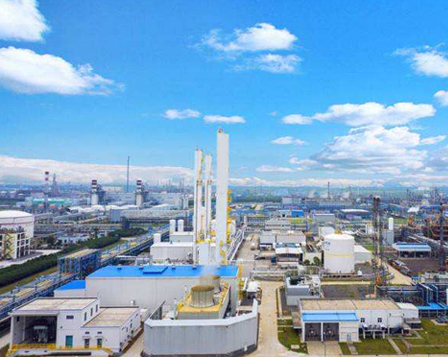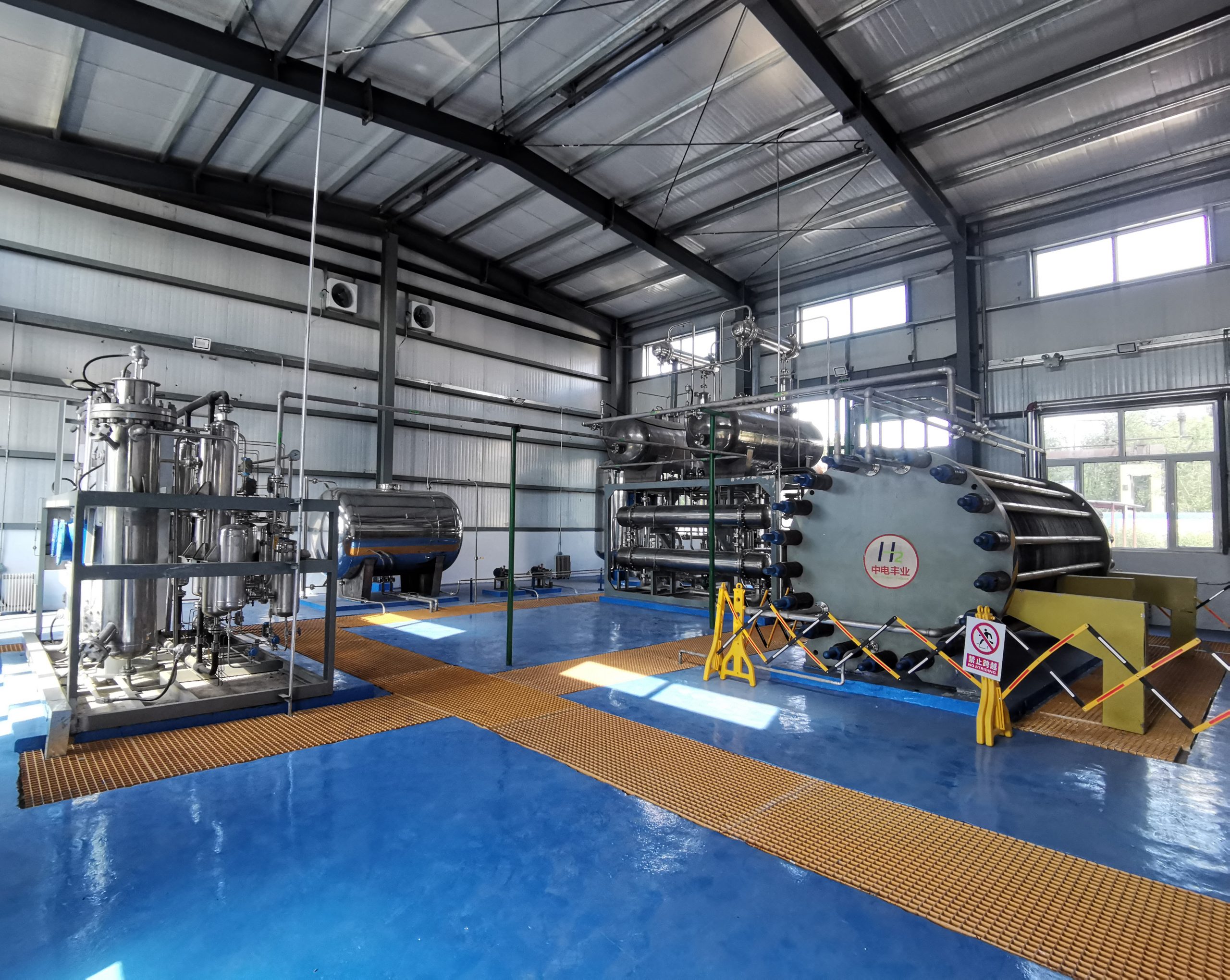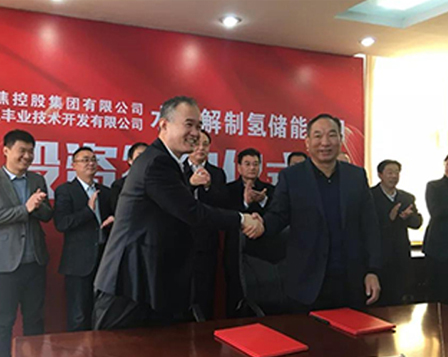News
-
2020-12-20
Around 2030, Water Electrolysis Hydrogen Generation will become the main body of effective hydrogen supply
Around 2030, Water Electrolysis Hydrogen Generation will become the main body of effective hydrogen supply On June 26, the China Hydrogen Energy Alliance released the White Paper on China's Hydrogen Energy and Fuel Cell Industry in Weifang, Shandong Province, which was jointly prepared and completed over 8 months by more than 30 domestic hydrogen energy and fuel cell industry backbone enterprises and scientific research institutions, including National Energy Group, Tongji University, Steel Research Group and Weichai Power. According to the white paper, at present, electrolytic hydro-hydrogen technology mainly includes alkaline hydrolytic solution tanks (AEs), proton exchange membrane hydro-hydro-hydro-hydro-solution tanks (PEMs) and solid oxide hydro-hydro-hydro solutions (SOEs). Among them, alkaline electrolytic cell technology is the most mature, low generation costs, the maximum gas generation of a single unit in China is 1000 cubic meters / hour; PEM electrolysis process is simple, high energy efficiency, the maximum gas generation of a single unit in China is 50 cubic meters / hour, but due to the use of precious metal electrocatalysts and other materials, the cost is high; Solid oxide hydropower solution tank uses water vapor electrolysing, works at high temperature and has the highest energy efficiency, but is still in the laboratory research and development stage. The white paper believes that at present, the domestic hydrogen energy industry is still in the market import stage, in addition to some gas companies, market-oriented hydrogen supply channels are limited. Combined with the generation capacity, economy and carbon emissions of hydrogen in different technical routes, different regions have to choose according to their resource endowments. The white paper predicts that, overall, China's hydrogen energy market in the early stages of development (around 2020-2025), the average annual demand for hydrogen is about 22 million tons, as fuel increment is limited, industrial by-generation hydrogen due to low costs, and close to the consumer market, will become an effective hydrogen supply body, some areas can explore the development of renewable energy electrolyte hydrogen project demonstration. Hydrogen market development in the medium term (around 2030), the average annual demand for hydrogen is about 35 million tons, coal hydrogen with CCS technology, renewable energy electrolytic hydro-hydrogen will become an effective hydrogen supply body, and actively promote biological hydrogen and solar photo-catalytic decomposition of water-based hydrogen and other technology demonstration, hydrogen to achieve long-distance large-scale transport. Hydrogen energy market development in the long term (around 2050), the average annual demand for hydrogen is about 60 million tons, China's energy structure from traditional fossil energy-based to renewable energy-based multi-pattern, renewable energy electrolytic hydro-hydrogen will become an effective hydrogen supply body, coal-based hydrogen with CCS technology, biological hydrogen and solar photocatalytic decomposition of water-based hydrogen and other technologies to become an effective complement, the overall hydrogen energy supply is abundant, and can achieve 10 million tons of green hydrogen exports. Public information shows that the China Hydrogen Energy Alliance, known as China Hydrogen Energy and Fuel Cell Industry Innovation Strategy Alliance, is led by the National Energy Group, jointly launched 17 large enterprises, well-known universities and research institutions in China's energy generation, equipment manufacturing, transportation, metallurgical materials and other industries. The main duties of the China Hydrogen Energy Alliance are to study the development model of hydrogen energy and fuel cell industry with Chinese characteristics, to issue regular industrial white papers, and to provide policy advice and intellectual support for the formulation of hydrogen energy and fuel cell development strategies and implementation programs for the country. At present, Xu Guanhua, former minister of the Ministry of Science and Technology and a member of the Chinese Academy of Sciences, serves as the director of the Strategic Steering Committee of the China Hydrogen Energy Alliance, the former vice president of the Chinese Academy of Engineering and the chinese Academy of Engineering, and the executive vice-chairman of the Strategic Steering Committee, and Ling Wen, a member of the Chinese Academy of Engineering who has been transferred from the general manager of the State Energy Group to the vice-governor of Shandong Province, serves as the chairman of the board of directors of the China Hydrogen Energy Alliance.
-
2020-10-25
New breakthrough in the study of hydrogen production by electrolysis of water
In December 2018, the National Development & Reform Commission and the National Energy Administration jointly issued the "Clean Energy Consumption Action Plan (2018-2020)" (hereinafter referred to as the "Plan"). The "Plan" pointed out that exploring the conversion of surplus renewable energy into electricity Heat energy, cold energy, hydrogen energy, realize the efficient use of renewable energy in multiple ways. Hydrogen generation by electrolysis of water is a good way to convert surplus electricity into hydrogen energy. Recently, Chen Liang’s team, a researcher from the Institute of New Energy, Ningbo Institute of Materials Technology and Engineering, Chinese Academy of Sciences, provided a highly efficient acidic oxygen evolution electrocatalyst and proposed a corresponding mechanism explanation, which to a certain extent promoted the generation of hydrogen from acidic electrolyzed water. Related research is published in "Nature-Communication". Hydrogen generation by electrolysis of water to achieve surplus power conversion Both hydrogen energy and electric energy are important secondary energy sources and are also the main green and clean energy sources in the future. Hydrogen has no pollution and zero emissions, and will play an extremely important role in human life and production in the future. Hydrogen energy has the characteristics of long-distance transportation, large-scale storage and hydrogen-electricity interchange. The current main generation methods include hydrogen generation from fossil fuels, hydrogen generation from water electrolysis, and industrial by-product hydrogen. Chen Liang, a researcher at the Ningbo Institute of Materials Technology and Engineering of the Chinese Academy of Sciences and the corresponding author of the paper, explained to the China Science Daily in an interview: “At present, the industry mainly uses fossil fuel reforming to produce hydrogen. Fossil fuels can be natural gas, petroleum and coal. The energy contained in hydrogen produced by this method is lower than the energy contained in the original fossil fuel because of the heat loss. In addition, the hydrogen produced by this method does not reduce carbon dioxide emissions, because the carbon dioxide emitted by the process of reforming hydrogen is the same as the carbon dioxide emitted by direct burning of fossil fuels." At present, the methods for hydrogen generation by reforming alternative fossil fuels under research in the laboratory stage include biological hydrogen generation, hydrogen generation by electrolysis of water, photoelectrochemical hydrogen generation and photoelectrocatalytic hydrogen generation. Among them, the technology of hydrogen generation by electrolysis has already reached a certain scale application in industry. The main purpose of hydrogen generation by electrolysis of water is to convert surplus electricity into hydrogen energy. China has the world's largest wind power and solar power generation, but solar and wind power have intermittent problems, limited by day and night changes and climate factors. "The storage of electricity has always been a problem. The electricity that is not used up must be input to the national grid or converted into energy, otherwise it can only be wasted. Because the electricity generated by solar and wind energy is unstable and if directly input into the grid it will cause a series of problems. Therefore, we need to vigorously develop surplus power conversion technology." Chen Liang explained. New high-efficiency acidic oxygen evolution electrocatalyst. According to different electrolytes, hydrogen generation by electrolysis of water can be divided into alkaline electrocatalytic hydrogen generation and acidic electrocatalytic hydrogen generation. Chen Liang explained that the electrolysis of water involves two half reactions-the hydrogen evolution reaction on the cathode and the oxygen evolution reaction on the anode. According to different electrolytes, it is divided into alkaline electrolyzed water and acidic electrolyzed water. For alkaline electrolyzed water, the difficulty is hydrogen evolution on the cathode; for acidic electrolyzed water, the difficulty is oxygen evolution on the anode. According to reports, the industry has been relatively thorough in the research on alkaline electrolyzed water, and it has certain applications in industry. However, compared with alkaline electrolyzed water, acidic electrolyzed water is more popular. The reason is that the reaction rate of acidic electrolyzed water is 2 to 3 orders of magnitude faster, with fewer by-products, and proton exchange membrane (PEM) can be used, which in turn makes the stack very portable." The bottleneck restricting the development of acidic electrolyzed water is the oxygen evolution reaction on the anode, and there is still a lack of efficient acidic oxygen evolution electrocatalysts. This time, Chen Liang’s team provided a highly efficient new type of acidic oxygen evolution electrocatalyst—CrO2-RuO2 solid solution material, and proposed a corresponding mechanism explanation. Dr. Lin Yichao in the team successfully prepared a new type of CrO2-RuO2 solid solution material based on Cr-based metal-organic framework materials by adsorption of RuCl3 precursors and annealing. The structure of the CrO2-RuO2 solid solution was determined by PXRD crystal repair and Vegard’s law verification, and the Cr and Ru atoms were uniformly distributed in the same nano-single crystal through atomic-resolving spherical aberration electron microscope. Chen Liang pointed out that the preparation process is very simple, and the most important thing is to choose a suitable Cr-based metal organic framework material that can adsorb a large amount of RuCl3. "Tens of thousands of metal-organic framework materials have been reported so far, and there are also thousands of Cr-based materials. If blindly screening, the workload is very large. Thanks to the accumulation of research on metal-organic framework materials in the past ten years, rapid entry has been achieved. The results show that the CrO2-RuO2 solid solution material is used as the oxygen evolution electrocatalyst on the acidic electrocatalytic hydrogen generation anode, reducing the overpotential of the reaction, that is, reducing the energy consumption of the reaction. The material has an overpotential of only 178mV at a current density of 10mA·cm-2, and after 10,000 cycles, the overpotential has only increased by 11mV, which is far better than commercial RuO2. Through the synchrotron radiation near-side absorption test, it is found that the valence state of Ru atoms in the crystal structure is slightly higher than +4 due to the strong electron withdrawing effect of 4-valent Cr, and the bond length of Ru-O becomes shorter. Through density functional simulation calculations , Dr. Ziqi Tian of this team found that it is precisely the electron withdrawing effect of +4-valent Cr in the crystal lattice that the catalytic activity of Ru becomes higher and the reaction energy barrier is lowered. In addition, it is worth noting that the content of precious metal Ru in the solid solution material is only 40%, which can significantly reduce the cost of the catalyst. According to reports, RuO2 and IrO2 and their derivatives are currently recognized catalysts with acidic oxygen evolution electrocatalytic activity. The acidic oxygen evolution activity of IrO2-based materials is very stable, but the price of Ir is very expensive. The current market price of Ir metal is about 390 yuan/g. In contrast, Ru metal is the cheapest platinum group element, the price is about 60 yuan / gram. Although RuO2-based materials have high electrocatalytic activity for acidic oxygen evolution, they are very unstable. The new CrO2-RuO2 solid solution material reported this time has the highest acidic oxygen evolution electrocatalytic activity, and can be stable for 10 hours at a current density of 10mA·cm-2, far superior to commercial RuO2. Chen Liang gave the following figures: "The molecular formula of the new material is Cr0.6Ru0.4O2, and the price of Cr is 0.4 yuan/gram, which is almost negligible compared to the price of Ru. Therefore, simply estimate the cost from the element composition, it can be reduced by about 60%. Of course, the premise is that large-scale preparation methods for new materials must also be developed." Hydrogen energy is the most promising secondary energy The global hydrogen industry is developing rapidly, with the market size growing from US$187.082 billion in 2011 to US$251.493 billion in 2017, a growth rate of 34.4%. Among them, the United States is the largest importer of industrial hydrogen, while the Netherlands is the largest exporter of industrial hydrogen. According to data, in 2017, more than 96% of the world's main artificial hydrogen generation raw materials were derived from the thermochemical reforming of traditional fossil resources, and only about 4% were derived from electrolyzed water. Coal and natural gas are also the main raw materials for artificial hydrogen generation in our country, accounting for 62% and 19% respectively. According to the "Blue Book of Infrastructure Development of China's Hydrogen Energy Industry (2018)", China's hydrogen generation in 2016 was approximately 21 million tons, of which coal produced hydrogen accounted for 62%, which was the main source of hydrogen; natural gas produced hydrogen followed by 19 %. Zou Caineng, academician of the Chinese Academy of Sciences and vice president of the China Petroleum Exploration and Development Research Institute, analyzed that although coal gasification hydrogen generates a large amount of carbon dioxide, it is still a large-scale, low-cost and best way to artificial hydrogen generation due to its abundant raw materials and low prices. Blast furnace flue gas, chemical exhaust gas, etc. can achieve low-cost recovery of hydrogen through pressure swing adsorption (PSA) technology. Solar hydrogen generation technology (photocatalysis, photopyrolysis) is the ideal hydrogen generation technology in the future, but it is subject to problems such as conversion efficiency and cost are expected to be difficult to achieve large-scale before 2030. Among all the artificial hydrogen generation methods, hydrogen generation by electrolysis of water will run through the entire process of hydrogen energy development, and it is one of the main sources of industrial hydrogen for the construction of a future "hydrogen energy society". With the continuous development of water electrolysis hydrogen generation technology and the gradual reduction of costs, electrolysis water hydrogen generation will gradually meet the requirements of commercialization and realize distributed hydrogen generation. Chen Liang said that their team will continue to optimize the preparation method of CrO2-RuO2 solid solution materials in the future. At present, the metal-organic framework material is still in the laboratory stage and has not been commercialized. The team will try to use other commercially available and cheap Cr-based raw materials. In addition, they will also try to use the same strategy to prepare other rutile solid solution materials, such as MnO2-RuO2 solid solution, in order to obtain higher performance acidic oxygen evolution electrocatalysts.
-
2020-10-20
Hydrogen energy storage: a new way to solve the problem of "abandoning the wind and discarding light"!
Hydrogen energy storage is a new concept put forward after the comprehensive utilization of hydrogen energy in Germany and other European countries in the past two years. "12th Five-Year Plan" has not been established before, support projects are also hydrogen generation, power generation, hydrogen storage and other processes separately funded, but the "13th Five-Year Plan" period of the concept has been included in the National Grid Corporation planning. Hydrogen energy storage technology is considered to be an important support for the large-scale development of smart grid and renewable energy generation, and has increasingly become the focus of energy technology innovation and industry support in many countries. We will vigorously develop hydrogen energy storage technology, focus on breaking through the key technologies such as high-efficiency conversion, low-cost large-scale storage and comprehensive and efficient utilization of two energy carriers, solve the key technologies such as hydrogen generation of new energy volatility, interconnection and coordinated control of power grid and pipe network, realize large-scale storage of energy network, and realize the large-scale application of high-efficiency and low-cost energy storage technology. To provide technical support for the construction of a global energy Internet with strong configuration capabilities, high safety and reliability, and green and low carbon. A new way of thinking to solve the problem of "abandoning the wind" and "abandoning the light" With the rapid increase in the proportion of renewable energy generation in China (according to the latest forecast of the Energy Research Institute of the National Development and Reform Commission: the proportion of renewable energy generation in China's power structure will increase from 24% in 2015 to 53%) in 2030), there is also a geographical distribution of power generation and load centers (80%-90% of wind on-land resources in the "three north" region, solar energy resources are also in the west and north, and energy centers are located in the middle and east), In view of the increasingly urgent environmental pressure and fossil energy constraints, which have forced China to focus on the generation, storage and consumption of renewable energy, in early 2014, Premier Li Keqiang visited the German hydrogen energy hybrid power generation project, in particular instructing the relevant domestic departments to organize the implementation of hydrogen energy utilization demonstration projects. The State Energy Administration has instructed Hebei and Jilin provinces to speed up the demonstration of hydrogen generation from renewable sources, and to list hydrogen storage as a new way of thinking to solve the problem of "abandoning wind" and "abandoning light". In the two months of early 2015, the State Energy Administration again issued a series of circulars related to wind power consumption ("National Energy Administration on doing a good job in 2015 wind power grid-related work", "National Energy Administration on the implementation of renewable energy clean heating demonstration in Beijing related requirements", "National Energy Administration Integrated Division on the further development of renewable energy "13th Five-Year Plan" guidance"), renewable energy consumption work is imminent. To this end, State Grid Corporation has also carried out the key technology of hydrogen energy storage and its pre-application research in new energy access, actively built an experimental research platform for hydrogen energy storage system, broke through the adapt
-
2020-10-16
Hydrogen fuel cell is the best energy storage in the future
Charging for two minutes and driving for two hours is what new energy vehicle owners most hope to happen. Although it is still difficult to solve this problem by relying on lithium batteries, it is easy to switch to hydrogen fuel. So what hinders the promotion of hydrogen fuel cell vehicles? "When it comes to hydrogen, everyone is doubtful about its safety, but there is sufficient evidence that hydrogen is very safe as energy source. Therefore, it is necessary to strengthen popular science and promote the utilization rate of hydrogen stations and hydrogen fuel cell vehicles.” On October 17, Zhang Jinhua, executive vice chairman and secretary general of the China Society of Automotive Engineering, suggested at the 6th China-Korea Automotive Industry Development Seminar.






